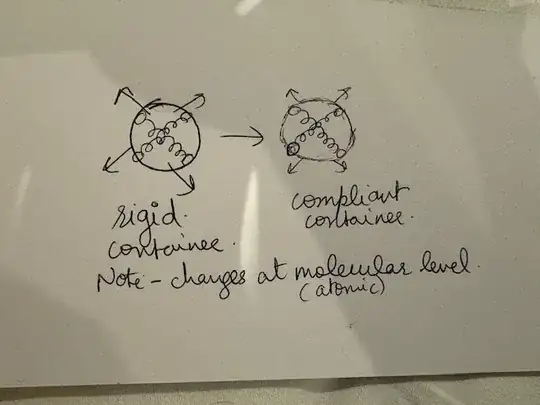A broad and useful framework to predict what does occur in this context (as opposed to what could occur through energy conservation alone, the First Law of Thermodynamics) is minimization of a relevant energy, a consequence of the Second Law of Thermodynamics.
Mathematically, this means taking the derivative of that energy with respect to the extent of any process that can occur (quantified by, e.g., a displacement or reaction coordinate) and setting that derivative to zero. This—along with the second derivative being positive, to ensure that the minimum is being identified—defines the equilibrium outcome.
This often has a simple interpretation: Forces balance. That framework is equivalent because forces are derivatives of energy with respect to displacements, so opposing forces equaling each other matches differentiating the total energy and setting the result to zero. Which framework is easier to intuit or analyze depends on the problem.
So what is the correct energy to take? In this case, one might explore adding up, say,
- the gravitational potential energy of the water and container walls (integrating $\rho g h\,dV$, with local density $\rho$ of an infinitesimal element, gravitational acceleration $g$, local height $h$ of the element, and differential volume $dV$),
- the surface energy of the water (integrating $s\,dA$, with local surface tension or interface energy penalty $s$ and differential area $dA$), and
- the strain energy within the water and container walls (under a linear-elasticity assumption of slight deformation, integrating $\boldsymbol\sigma\boldsymbol\varepsilon\,dV = \frac{1}{2}\boldsymbol{C\varepsilon}^2\,dV$, with local stress $\boldsymbol\sigma$, local strain $\boldsymbol\varepsilon$, and stiffness $\boldsymbol C$, all generally tensors).
Other terms could be added to represent additional nuances, or some (such as the surface energy) could be ignored if they're insignificant relative to the others. If the liquid can be considered incompressible, one could replace its gravitational potential energy with $mg\bar h$, with liquid mass $m$ and center-of-mass height $\bar h$. In a liquid under only slight compression (i.e., essentially constant volume $V$), the strain energy is essentially $\frac{1}{2}KV\varepsilon^2$, with bulk modulus $K$; the stress and strain tensors have simplified to represent pressure and volumetric strain $\varepsilon$ alone, as fluids can't sustain a shear stress. In a gas, the isothermal bulk modulus is more or less its pressure, exactly so for the ideal gas.
If some change can be envisioned that monotonically lowers the total energy, it is spontaneous. (Alternatively, in the force framework, a net force acting on an object tends to move it.) Equilibrium corresponds to a slight rearrangement always increasing the total energy; some energy component terms may decrease—referred to as an energy benefit below—but others increase by a greater amount, referred to as an energy penalty below. (An example of the latter is progressive deformation of an elastic object, where the stored strain energy increases with the square of the deformation.)
Example: For a liquid floating in zero gravity (surrounded by its equilibrium vapor pressure to preclude evaporation), without a container, the surface shape minimizes to a sphere with size such that any tighter squeezing would incur a strain energy penalty greater than the surface energy benefit.
Example: For a liquid in a rigid container in a gravity field, a pressure and density gradient arises wherein the liquid compresses until the strain energy penalty matches the gravitational potential benefit of allowing liquid above it to be lower.
Example: A mixture of gases in a gravity field (or a centrifuge) exhibits enrichment of the heavier gases.
Example: To finally address your question, upon replacing the rigid container with a flexible container, the container expands and sags until the strain energy penalty of further container deformation becomes as large as (again) the energetic payoff of the liquid moving lower. As mentioned above, deformation stores energy quadratically, but losing height releases energy only linearly. At some point, these changes exactly counteract. In the force framework, deformation of the container wall stops when the outward force applied by the liquid's pressure balances the inward force applied by the wall's hoop stress, for instance. Again, it may be easier depending on the circumstances to perform analysis by either balancing forces at different regions or to write an expression for the total energy and to minimize it.
Why is energy minimization arguably more useful than energy conservation here? For systems in thermal contact with their surroundings, a spontaneous process typically causes heat transfer between the system and the surroundings, and a conservation-of-energy analysis would require this heating to be tracked and incorporated. If you hang a weight on a spring (potential energy $-mgx$, spring constant $k$), for example, the weight will oscillate, and the motion will be damped out to stop at the equilibrium position $\frac{mg}{k}$ below, storing energy $\frac{1}{2}kx^2 = \frac{mgx}{2}$ in the spring. Fully half the original energy has been lost to friction! Energy minimization avoids the need to consider this heating; indeed, minimization of the total gravitational and strain energy $-mgx+\frac{1}{2}kx^2$ gives the spring relation $x=-\frac{mg}{k}$. With this simple example, a force balance is enough, but the broader framework described in this answer provides an alternate way to handle more complex container wall deformations in the original problem, which involves not uniaxial stretching but perhaps biaxial stretching, bending, and shear.
